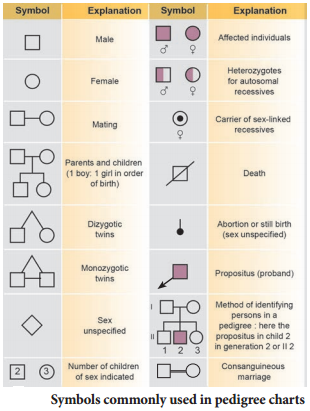Learninsta presents the core concepts of Biology with high-quality research papers and topical review articles.
Pedigree Analysis – Genetic Disorders
Pedigree is a “family tree”, drawn with standard genetic symbols, showing the inheritance pathway for specific phenotypic characters.(Fig. 4.6). Pedigree analysis is the study of traits as they have appeared in a given family line for several past generations.

Genetic Disorders
A genetic disorder is a disease or syndrome that is caused by an abnormality in an individual DNA. Abnormalities can range from a small mutation in a single gene to the addition or subtraction of an entire chromosome or even a set of chromosomes. Genetic disorders are of two types namely, Mendelian disorders and chromosomal disorders.
A pedigree shows relationships between family members and indicates which individuals have certain genetic pathogenic variants, traits, and diseases within a family as well as vital status. A pedigree shows relationships between family members and patterns of inheritance for certain traits and diseases.
Pedigrees are drawn using standard symbols and formatting. Males are represented by squares and females by circles. Individuals who are deceased have a slash through the symbol representing them. Symbols for individuals affected by a particular disorder are shaded.
It can be simply called as a “family tree” Pedigrees use a standardized set of symbols, squares represent males and circles represent females.
The modes of inheritance are autosomal dominant , autosomal recessive, and X-linked. To simplify the discussion of these different forms, the trait used in the following text will be a hereditary disease.
In this family pedigree, black squares indicate the presence of a particular trait in a male, and white squares represent males without the trait. White circles are females. A trait in one generation can be inherited, but not outwardly apparent before two more generations (compare black squares).
There are five basic modes of inheritance for single-gene diseases: autosomal dominant, autosomal recessive, X-linked dominant, X-linked recessive, and mitochondrial. Genetic heterogeneity is a common phenomenon with both single-gene diseases and complex multi-factorial diseases.
The study of an inherited trait in a group of related individuals to determine the pattern and characteristics of the trait, including its mode of inheritance, age of onset, and phenotypic variability.